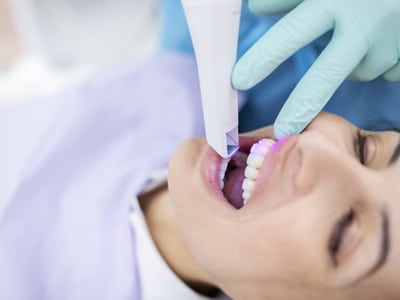What is a Digital Impression?

What’s the Difference Between Traditional and Digital Impressions?
So, the obvious difference here is that one of these methods involves putting a chemical-tasting goop into the patient’s mouth and holding it there for minutes on end, often having the patient sit still. This impairs breathing, and movement, and can trigger gag reflexes and mild choking.
The traditional dental impression has some constraints. It must deal with moisture well, so typically consideration for water-friendly versus water-repellent is important on a case-by-case basis. The material must also remain stable after the chemical reaction which sets the impression in the mouth. These basic requirements for a safe and effective impression lead to uncomfortable consistencies and taste. Most polymers used for traditional impressions are hydrophilic polyether, vinyl polysiloxane (VPS), and hybrid VPES.
Digital impressions are completely computerized. There are no words that sound like a high school chemistry flashback, and they don’t impair breathing or cause gagging. The highly advanced camera technology allows for accuracy and speed that was previously impossible with chemical impression technology.
What are the benefits of Digital Impressions?
Digital impressions are many times more accurate than traditional impressions. They remain usable even if patients move during the process, which renders traditional impressions useless. Digital impressions are also much faster. Both the actual process of taking photos and the turnaround time for lab analysis are greatly reduced, which leads to a streamlined treatment process.
Digital impressions are also more sustainable and have long-term environmental benefits. Digitization of orthodontia is important to our dedication to a more sustainable future in the field.
These impressions are first and foremost more accurate. The computer and high-resolution photography capabilities allow for our expert team to visualize your teeth in 3D, as well as to predict their future movement as you grow and as treatment progresses. More accurate impressions allow for more accurate treatment planning and occlusion diagnosis, which means more long-lasting successful treatment for our patients.
What is the Process of Getting a Digital Impression?
An orthodontist or an orthodontic assistant will move a small wand around your mouth. The camera at the end of the wand captures your teeth and gums from all angles and gets an accurate picture of your jaw and bite. The camera can take around 3000 pictures per minute and is the most accurate way for the orthodontist to view and diagnose issues in your bite swiftly.
If you have questions or concerns about how our practice uses the digital impression system, please reach out and ask. We are here for you and are happy to answer any questions you may have.